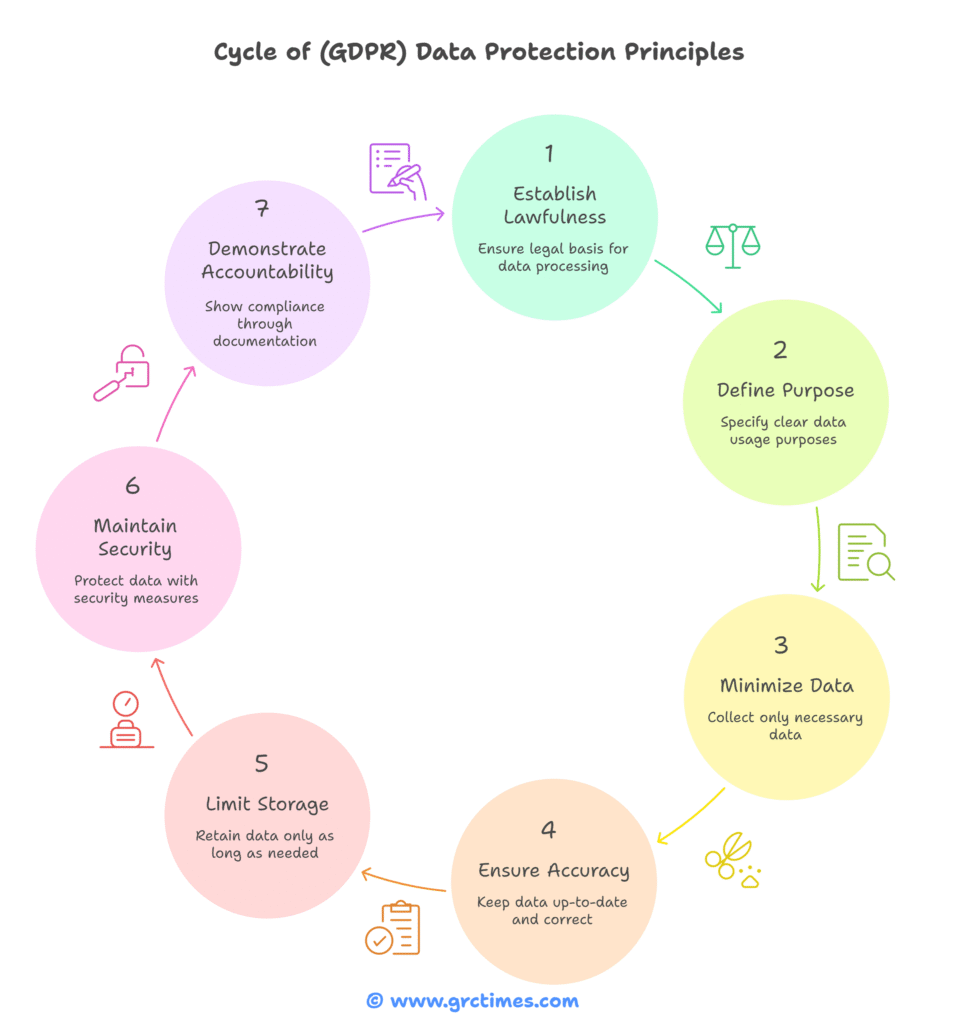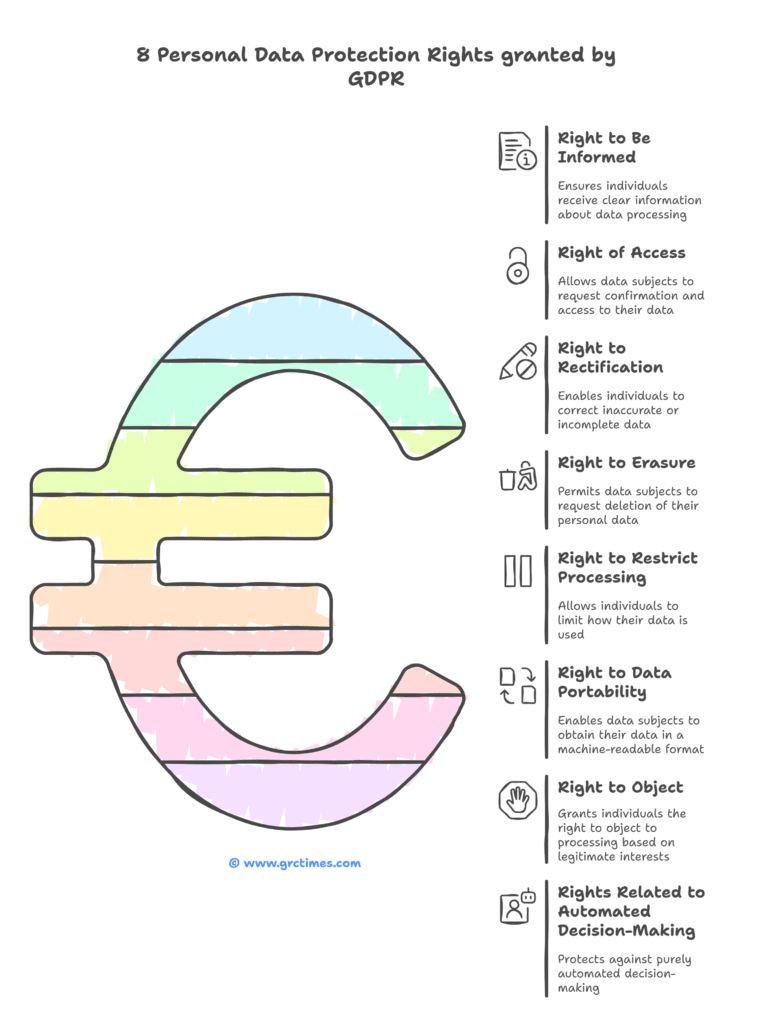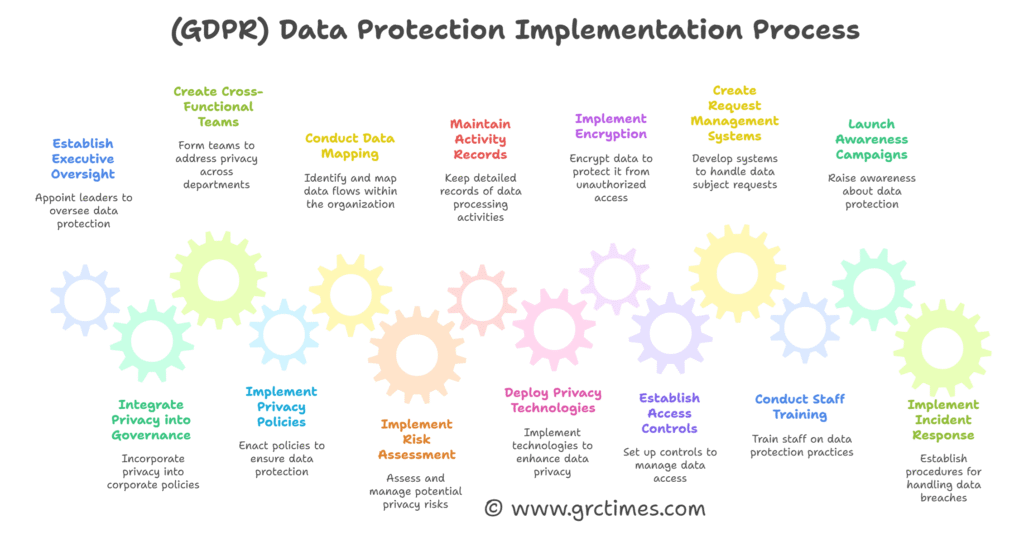Every organization handling European Union citizens’ personal data faces a regulatory framework so comprehensive and punitive that a single violation can result in fines reaching 4% of global annual revenue—or €20 million, whichever is higher. Since its implementation in May 2018, the General Data Protection Regulation has fundamentally transformed how businesses worldwide approach data privacy, with cumulative fines reaching €5.88 billion by January 2025, including the record-breaking €1.2 billion penalty against Meta Platforms Ireland Limited.
The General Data Protection Regulation (GDPR) Implemented on May 25, 2018, replaced the 1995 Data Protection Directive and established uniform data protection standards across all 27 EU member states plus Iceland, Liechtenstein, and Norway within the European Economic Area.
The GDPR’s territorial scope extends beyond EU borders through its “extraterritorial effect,” meaning that any organization processing EU residents’ personal data must comply regardless of their physical location. This global reach has made GDPR a de facto international standard, influencing privacy legislation worldwide and forcing multinational corporations to adopt comprehensive data protection programs.
At its core, GDPR is built on seven fundamental principles that govern all data processing activities: lawfulness, fairness, and transparency; purpose limitation; data minimization; accuracy; storage limitation; integrity and confidentiality; and accountability. These principles work together to ensure that personal data is processed ethically, securely, and with full respect for individual privacy rights.
Who It Applies To
Data Controllers
Organizations that determine the purposes and means of processing personal data, including:
- Companies collecting customer information
- HR departments processing employee data
- Marketing agencies managing consumer databases
- Healthcare providers maintaining patient records
- Educational institutions handling student information
Data Processors
Organizations that process personal data on behalf of controllers, such as:
- Cloud service providers hosting data
- IT outsourcing companies managing systems
- Marketing agencies processing data for clients
- Payroll service providers
- Third-party analytics companies
Territorial Scope
The GDPR applies to organizations:
- Established in the EU processing personal data
- Not established in the EU but offering goods/services to EU residents
- Not established in the EU but monitoring behavior of EU residents
- Processing data of EU residents regardless of citizenship status
Key Requirements and Principles
The Seven GDPR Principles

1. Lawfulness, Fairness, and Transparency
Organizations must process personal data legally, fairly, and transparently. This requires:
- Establishing a lawful basis for processing under Article 6
- Providing clear privacy notices explaining data usage
- Ensuring processing doesn’t harm data subjects’ interests
- Avoiding deceptive or misleading practices
2. Purpose Limitation
Personal data must be collected for specified, explicit, and legitimate purposes and not processed in ways incompatible with those purposes. Organizations must:
- Define clear purposes before collecting data
- Document all processing purposes
- Avoid “mission creep” in data usage
- Obtain new consent for incompatible purposes
3. Data Minimization
Only collect and process data that is adequate, relevant, and necessary for the intended purpose:
- Collect only essential data elements
- Regularly review data collection practices
- Implement data reduction strategies
- Justify retention of all data categories
4. Accuracy
Personal data must be accurate and kept up-to-date, with inaccurate data erased or rectified promptly:
- Implement data validation procedures
- Establish correction mechanisms
- Monitor data quality continuously
- Enable subject-initiated corrections
5. Storage Limitation
Data must be kept only as long as necessary for the stated purposes:
- Define retention schedules for all data categories
- Implement automated deletion procedures
- Document retention justifications
- Regularly review and purge unnecessary data
6. Integrity and Confidentiality
Process data securely using appropriate technical and organizational measures:
- Implement encryption and pseudonymization
- Establish access controls and authentication
- Monitor for security breaches
- Maintain audit trails
7. Accountability
Controllers must demonstrate compliance with all principles through documentation and governance:
- Maintain processing records
- Conduct privacy impact assessments
- Implement privacy by design
- Provide staff training
Lawful Bases for Processing
Article 6 establishes six lawful bases for processing personal data:
| 1. Consent | 2. Contract |
| – Must be freely given, specific, informed, and unambiguous – Requires clear affirmative action (no pre-ticked boxes) – Must be easily withdrawable – Children under 16 require parental consent (Member States may lower to 13) | – Processing necessary for contract performance – Includes pre-contractual measures – Must be genuinely necessary, not just convenient |
| 3. Legal Obligation | 4. Vital Interests |
| – Required by EU or Member State law – Must specify the legal provision – Cannot be used for voluntary compliance | – Necessary to protect life or prevent serious harm – Typically reserved for emergency situations – Rarely applicable to commercial processing |
| 5. Public Task | 6. Legitimate Interests |
| – Processing by public authorities – Exercise of official authority – Must be established by law | – Most flexible but requires balancing test – Must demonstrate legitimate business need – Cannot override data subject rights – Requires impact assessment |
Data Subject Rights
The GDPR grants individuals eight fundamental rights over their personal data:

1. Right to Be Informed (Articles 12-14)
Individuals must receive clear information about data processing before or at the time of collection:
- Identity and contact details of controller
- Purposes and lawful basis for processing
- Categories of data collected
- Recipients of the data
- Retention periods
- Rights available to the data subject
2. Right of Access (Article 15)
Data subjects can request confirmation of processing and access to their data:
- Confirmation of processing activities
- Copy of personal data undergoing processing
- Additional information about processing
- Must respond within one month
- First copy provided free of charge
3. Right to Rectification (Article 16)
Individuals can request correction of inaccurate or incomplete data:
- Obligation to correct inaccurate data
- Must be completed without undue delay
- Notification to third parties may be required
- Includes right to complete incomplete data
4. Right to Erasure/”Right to Be Forgotten” (Article 17)
Data subjects can request deletion of their personal data when:
- Data no longer necessary for original purpose
- Consent is withdrawn and no other lawful basis exists
- Data has been unlawfully processed
- Legal obligation requires erasure
- Data was collected from children
5. Right to Restrict Processing (Article 18)
Individuals can limit how their data is used:
- When accuracy is contested
- Processing is unlawful but erasure is opposed
- Data no longer needed but required for legal claims
- Objection to processing is under consideration
6. Right to Data Portability (Article 20)
Data subjects can obtain their data in machine-readable format:
- Applies only to automated processing
- Based on consent or contract
- Must be in structured, commonly used format
- Includes right to transmit to another controller
7. Right to Object (Article 21)
Individuals can object to processing based on:
- Legitimate interests
- Public task
- Direct marketing (absolute right)
- Scientific/historical research
8. Rights Related to Automated Decision-Making (Article 22)
Protection against purely automated decision-making:
- Right not to be subject to automated decisions
- Exceptions for contract necessity or consent
- Right to human review
- Right to challenge decisions
Data Protection Impact Assessments (DPIAs)
DPIAs are mandatory when processing is likely to result in high risk to data subjects, particularly for:
- Systematic and extensive profiling with legal effects
- Large-scale processing of special category data
- Systematic monitoring of public areas
- Use of new technologies
- Processing that prevents data subjects from exercising rights
DPIA Process:
- Describe processing operations and purposes
- Assess necessity and proportionality
- Identify and analyze risks to data subjects
- Identify measures to address risks
- Consult supervisory authority if high risk remains
Privacy by Design and by Default
Article 25 requires organizations to implement data protection by design and by default:
Privacy by Design
- Embed privacy considerations from project inception
- Implement appropriate technical and organizational measures
- Consider state of the art and implementation costs
- Address the nature, scope, and context of processing
Privacy by Default
- Set most privacy-friendly settings as default
- Process only necessary data for each purpose
- Limit data collection, processing, and retention
- Restrict data accessibility by default
Data Protection Officers (DPOs)
DPO appointment is mandatory for:
- Public authorities (except courts in judicial capacity)
- Organizations whose core activities involve regular, systematic monitoring on a large scale
- Organizations whose core activities involve large-scale processing of special category data
DPO Requirements:
- Expert knowledge of data protection law and practices
- Report to highest management level
- Perform duties independently
- Not receive instructions regarding DPO tasks
- Adequate resources and support
- Involved in all data protection matters
DPO Tasks:
- Inform and advise organization and employees
- Monitor compliance with GDPR
- Conduct training for staff
- Advise on DPIAs and monitor performance
- Cooperate with supervisory authorities
- Act as contact point for data subjects and authorities
International Data Transfers
The GDPR restricts transfers of personal data outside the European Economic Area unless adequate protection is ensured:
Adequacy Decisions
The European Commission has recognized the following countries as providing adequate protection:
- Andorra, Argentina, Canada (commercial organizations)
- Faroe Islands, Guernsey, Israel, Isle of Man, Japan
- Jersey, New Zealand, Republic of Korea, Switzerland
- United Kingdom, United States (EU-US Data Privacy Framework participants)
- Uruguay
Standard Contractual Clauses (SCCs)
Pre-approved contract templates that provide adequate safeguards:
- Module 1: Controller to controller transfers
- Module 2: Controller to processor transfers
- Module 3: Processor to processor transfers
- Module 4: Processor to controller transfers
Other Safeguards:
- Binding Corporate Rules (BCRs)
- Codes of conduct with binding commitments
- Certification mechanisms with binding commitments
- Ad hoc contractual clauses approved by supervisory authorities
GDPR Enforcement and Penalties
The GDPR establishes a two-tier fine structure:
Administrative Fines – Lower Tier (Article 83(4))
Up to €10 million or 2% of global annual turnover for:
- Failure to implement data protection by design and default
- Failure to appoint required DPO
- Inadequate records of processing activities
- Failure to conduct required DPIA
Administrative Fines – Upper Tier (Article 83(5))
Up to €20 million or 4% of global annual turnover for:
- Processing without lawful basis
- Violating data subject rights
- Unlawful international transfers
- Non-compliance with supervisory authority orders
Recent Enforcement Trends and Notable Cases
Record-Breaking Penalties
The largest GDPR fines demonstrate the regulation’s significant financial impact:
- Meta Platforms Ireland Limited: €1.2 billion (May 2023) – International data transfers
- Amazon Europe Core S.à.r.l.: €746 million (July 2021) – Processing principles violations
- Meta Platforms, Inc.: €405 million (September 2022) – Processing principles violations
Enforcement Statistics
As of March 2025:
- Total fines imposed: 2,245 (€5.65 billion cumulative)
- Spain leads in number of fines: 932 total
- Ireland leads in fine amounts: €3.5 billion total
- Average fine across all countries: €2.36 million
Common Violation Categories:
- Insufficient legal basis for processing (most common)
- Non-compliance with general processing principles
- Inadequate technical and organizational security measures
- Insufficient fulfillment of information obligations
- Inadequate respect for data subject rights
GDPR Implementation Best Practices
Step 1 – Governance Framework
Establish executive oversight to drive accountability in data protection and integrate privacy into corporate governance structures. Form cross-functional teams to align compliance, legal, IT, and business functions, and implement well-defined, privacy-focused policies and procedures to support consistent execution.
Step 2 – Risk Assessment and Management
Conduct thorough data mapping to understand how personal data flows across systems and geographies. Implement privacy risk assessment frameworks to identify and mitigate exposure. Maintain up-to-date records of processing activities and perform regular audits to ensure ongoing compliance and accountability.
Step 3 – Technical Implementation
Deploy privacy-enhancing technologies such as encryption and pseudonymization to safeguard personal data. Establish strong access controls and authentication mechanisms, and implement systems to efficiently manage data subject requests and rights.
Step 5 – Organizational Measures
Implement comprehensive staff training and data protection awareness programs to build a privacy-conscious culture. Establish clear incident response and breach notification procedures, and enforce robust vendor management and due diligence to mitigate third-party risks.

Recent Updates and Proposed Changes
2025 GDPR Amendments
The European Commission proposed amendments in May 2025 as part of the “Simplification Omnibus IV” package:
- Raised threshold for record-keeping obligations from 250 to 750 employees
- Simplified conditions for small and medium enterprises
- Reduced compliance burden for organizations unlikely to pose high risk
Artificial Intelligence Integration
The EU AI Act’s intersection with GDPR creates new challenges:
- Enhanced requirements for automated decision-making
- Special protections for AI training data
- New technical approaches to data subject rights implementation
- Intersection with algorithmic transparency obligations
Cross-Border Enforcement Cooperation
Increased coordination between EU data protection authorities has led to:
- Consistent interpretation of GDPR provisions
- Joint enforcement actions against multinational companies
- Standardized penalty calculation methodologies
- Enhanced information sharing mechanisms
Global Impact and Influence
The GDPR has inspired similar legislation worldwide, creating a “Brussels Effect” in privacy regulation:
GDPR-Inspired Laws:
- California Consumer Privacy Act (CCPA) and California Privacy Rights Act (CPRA)
- Brazil’s Lei Geral de Proteção de Dados (LGPD)
- South Korea’s Personal Information Protection Act amendments
- UK Data Protection Act 2018 and post-Brexit UK GDPR
Corporate Response:
Many multinational corporations have adopted GDPR as their global privacy standard due to:
- Operational efficiency considerations
- Consumer trust and brand reputation
- Competitive advantages in privacy-conscious markets
- Simplified compliance across multiple jurisdictions
Technology and Innovation Considerations
Emerging Technologies
GDPR compliance requires special attention for:
- Artificial Intelligence and Machine Learning systems
- Internet of Things (IoT) device deployments
- Blockchain and distributed ledger technologies
- Biometric recognition and processing systems
- Quantum computing and post-quantum cryptography
Privacy-Enhancing Technologies
Organizations increasingly adopt technical solutions including:
- Differential privacy for data analytics
- Homomorphic encryption for secure computation
- Federated learning for distributed AI training
- Zero-knowledge proofs for verification
- Secure multi-party computation protocols
Sector-Specific Considerations
Healthcare and Life Sciences
- Special category data processing requirements
- Research and clinical trial exemptions
- Medical device data protection obligations
- Health information exchange protocols
Financial Services
- Anti-money laundering and GDPR balance
- Credit scoring and automated decision-making
- Payment data protection requirements
- Customer due diligence procedures
Technology and Social Media
- Platform liability for user-generated content
- Advertising technology compliance
- Cross-border data transfer challenges
- Algorithm transparency obligations
In a world where data is the new currency, GDPR compliance is not merely a regulatory checkbox but a fundamental pillar of trust and competitive advantage. By embracing the principles of transparency, accountability, and privacy by design, organizations can transform stringent legal requirements into opportunities for innovation, customer loyalty, and global market leadership. As privacy landscapes evolve, staying proactive through continuous risk assessment, robust governance, and advanced technologies will be key to safeguarding personal data and sustaining long-term business success under the GDPR framework.
FAQs
What are the main differences between GDPR and other privacy laws?
GDPR differs from other privacy laws in several key ways: its extraterritorial scope applies globally to any organization processing EU residents’ data, regardless of location; the penalty structure allows fines up to 4% of global revenue or €20 million; it grants comprehensive individual rights including data portability and the right to be forgotten; and it requires explicit consent rather than implied consent for data processing.
How long do organizations have to respond to data subject requests?
Organizations must respond to data subject access requests within one month of receipt. This timeline can be extended by an additional two months for complex requests or high volumes, but the organization must inform the data subject of the extension and reasons within the initial one-month period. The first copy of personal data must be provided free of charge.
What constitutes a personal data breach under GDPR?
A personal data breach is any security incident that leads to accidental or unlawful destruction, loss, alteration, unauthorized disclosure, or access to personal data. This includes cyberattacks, employee errors, system failures, and physical theft of devices containing personal data. Organizations must notify supervisory authorities within 72 hours and affected individuals without undue delay if the breach poses high risk.
When is a Data Protection Impact Assessment required?
DPIAs are mandatory when processing is likely to result in high risk to data subjects, including: systematic and extensive profiling with legal effects; large-scale processing of special category data; systematic monitoring of publicly accessible areas; use of new technologies; processing that prevents data subjects from exercising rights; or when combining datasets from different sources.
Can organizations transfer personal data outside the EU?
Yes, but only with adequate protection measures. Data can be transferred to countries with EU adequacy decisions without additional safeguards. For other countries, organizations must implement appropriate safeguards such as Standard Contractual Clauses, Binding Corporate Rules, or obtain explicit consent. The transfer must also have a lawful basis under Article 6.
What are the requirements for valid consent under GDPR?
Valid consent must be freely given, specific, informed, and unambiguous. It requires a clear affirmative action (no pre-ticked boxes), must be easily withdrawable, and should be separate from other terms and conditions. For children under 16 (or lower age set by Member States), parental consent is required. Consent must be documented and renewable.
How does GDPR apply to artificial intelligence and automated decision-making?
GDPR Article 22 grants individuals the right not to be subject to purely automated decision-making with legal or significant effects. When such processing occurs, organizations must provide meaningful information about the logic involved, implement human oversight, and allow individuals to challenge decisions. AI systems using personal data must comply with all GDPR principles including data minimization and accuracy.
What are the key elements of privacy by design?
Privacy by design requires embedding data protection considerations from the earliest stages of system development. Key elements include: implementing appropriate technical and organizational measures; considering the state of technology and implementation costs; ensuring data minimization and purpose limitation; providing transparency and user control; maintaining full functionality while protecting privacy; and demonstrating accountability through documentation.
